
A lava tube, or pyroduct, is a natural conduit formed by flowing lava from a volcanic vent that moves beneath the hardened surface of a lava flow. If lava in the tube empties, it will leave a cave.

Ascraeus Mons is a large shield volcano located in the Tharsis region of the planet Mars. It is the northernmost and tallest of three shield volcanoes collectively known as the Tharsis Montes.

Arsia Mons is the southernmost of three volcanoes on the Tharsis bulge near the equator of the planet Mars. To its north is Pavonis Mons, and north of that is Ascraeus Mons. The tallest volcano in the Solar System, Olympus Mons, is to its northwest. Its name comes from a corresponding albedo feature on a map by Giovanni Schiaparelli, which he named in turn after the legendary Roman forest of Arsia Silva. Historically, it was known as Nodus Gordii before being renamed.

Rille is typically used to describe any of the long, narrow depressions in the surface of the Moon that resemble channels. The Latin term is rima, plural rimae. Typically, a rille can be several kilometers wide and hundreds of kilometers in length. However, the term has also been used loosely to describe similar structures on a number of planets in the Solar System, including Mars, Venus, and on a number of moons. All bear a structural resemblance to each other.
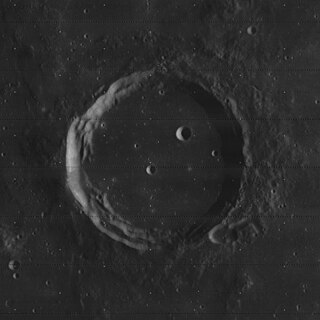
Marius is a lunar impact crater located on the Oceanus Procellarum. The surface to the west and north of this crater contains a large number of lunar domes spread across an area over a hundred kilometers in diameter that may be of volcanic origin dubbed the Marius Hills. These domes, if volcanic, may have been formed by magma that is fairly more viscous than the volcanic material that formed the basaltic lunar maria. The nearest named crater feature is Reiner to the southwest. Kepler is located to the east-southeast, and rays from that formation reach the rim of Marius.
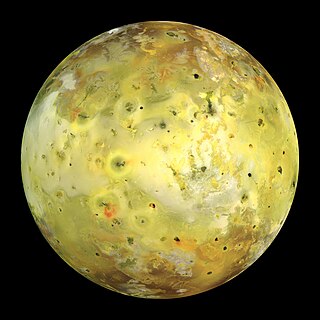
Io, or Jupiter I, is the innermost and second-smallest of the four Galilean moons of the planet Jupiter. Slightly larger than Earth's moon, Io is the fourth-largest moon in the Solar System, has the highest density of any moon, the strongest surface gravity of any moon, and the lowest amount of water by atomic ratio of any known astronomical object in the Solar System. It was discovered in 1610 by Galileo Galilei and was named after the mythological character Io, a priestess of Hera who became one of Zeus's lovers.

Alba Mons is a volcano located in the northern Tharsis region of the planet Mars. It is the biggest volcano on Mars in terms of surface area, with volcanic flow fields that extend for at least 1,350 km (840 mi) from its summit. Although the volcano has a span comparable to that of the United States, it reaches an elevation of only 6.8 km (22,000 ft) at its highest point. This is about one-third the height of Olympus Mons, the tallest volcano on the planet. The flanks of Alba Mons have very gentle slopes. The average slope along the volcano's northern flank is 0.5°, which is over five times lower than the slopes on the other large Tharsis volcanoes. In broad profile, Alba Mons resembles a vast but barely raised welt on the planet's surface. It is a unique volcanic structure with no counterpart on Earth or elsewhere on Mars.

Lacus Somniorum is a basaltic plain located in the northeastern part of the Moon's near side. It is located at selenographic coordinates 37.56° N, 30.8° E, and has a diameter of 424.76 kilometers. The name is Latin for Lake of Dreams, a title given to this feature by Giovanni Riccioli. It is the largest of the lunar features designated Lacus.

Lacus Mortis is a hexagonal-shaped plain of basaltic lava flows in the northeastern part of the Moon's near face. It was formed as a floor-fractured crater during the pre-Imbrian epoch, then flooded during the late Imbrian period. This feature lies just to the south of the elongated Mare Frigoris, being separated by a slender arm of rugged ground and linked at the eastern extreme. To the south is the Lacus Somniorum, separated from this mare by the joined craters Plana and Mason, and a strip of uneven surface.

The geology of the Moon is quite different from that of Earth. The Moon lacks a true atmosphere, and the absence of free oxygen and water eliminates erosion due to weather. Instead, the surface is eroded much more slowly through the bombardment of the lunar surface by micrometeorites. It does not have any known form of plate tectonics, it has a lower gravity, and because of its small size, it cooled faster. In addition to impacts, the geomorphology of the lunar surface has been shaped by volcanism, which is now thought to have ended less than 50 million years ago. The Moon is a differentiated body, with a crust, mantle, and core.
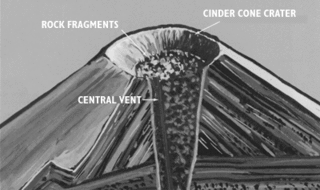
A cinder cone is a steep conical hill of loose pyroclastic fragments, such as volcanic clinkers, volcanic ash, or scoria that has been built around a volcanic vent. The pyroclastic fragments are formed by explosive eruptions or lava fountains from a single, typically cylindrical, vent. As the gas-charged lava is blown violently into the air, it breaks into small fragments that solidify and fall as either cinders, clinkers, or scoria around the vent to form a cone that often is symmetrical; with slopes between 30 and 40°; and a nearly circular ground plan. Most cinder cones have a bowl-shaped crater at the summit.

Volcanism on Io, a moon of Jupiter, is represented by the presence of volcanoes, volcanic pits and lava flows on the surface. Io's volcanic activity was discovered in 1979 by Linda Morabito, an imaging scientist working on Voyager 1. Observations of Io by passing spacecraft and Earth-based astronomers have revealed more than 150 active volcanoes. As of 2004, up to 400 such volcanoes are predicted to exist based on these observations. Io's volcanism makes the satellite one of only four known currently volcanically or cryovolcanically active worlds in the Solar System

Lacus Veris is a small lunar mare on the Moon. In selenographic coordinates, the mare centered at 16.5° S, 86.1° W and is approximately 396 km long. The mare extends along an irregular 90° arc from east to north that is centered on the Mare Orientale, covering an area of about 12,000 km2. Author Eric Burgess proposed this mare as the location of a future crewed lunar base, citing a 1989 study performed at the NASA Johnson Space Center.
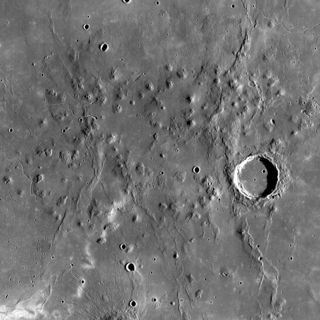
The Marius Hills are a set of volcanic domes located in Oceanus Procellarum on Earth's Moon. The domes are thought to have formed from lavas more viscous than those that formed lunar mares. These domes average approximately 200–500 m (660–1,640 ft) in height. The Marius Hills take their name from the nearby 41 km (25 mi) diameter crater Marius. These hills represent the highest concentration of volcanic features on the Moon.

Hadley–Apennine is a region on the near side of Earth's Moon that served as the landing site for the American Apollo 15 mission, the fourth crewed landing on the Moon and the first of the "J-missions", in July 1971. The site is located on the eastern edge of Mare Imbrium on a lava plain known as Palus Putredinis. Hadley–Apennine is bordered by the Montes Apenninus, a mountain range, and Hadley Rille, a meandering channel, on the east and west, respectively.

The Compton–Belkovich Thorium Anomaly is a volcanic complex on the far side of the Moon. It was found by a gamma-ray spectrometer in 1998 and is an area of concentrated thorium, a 'fertile' element. Lunar rock samples from the Apollo missions reveal that most lunar volcanism occurred around 3 to 4 billion years ago, but this feature could have formed as recently as 1 billion years ago due to the unknown history of the Moon's far side.

Martian lava tubes are volcanic caverns on Mars that are believed to form as a result of fast-moving, basaltic lava flows associated with shield volcanism. Lava tubes usually form when the external surface of the lava channels cools more quickly and forms a hardened crust over subsurface lava flows. The flow eventually ceases and drains out of the tube, leaving a conduit-shaped void space which is usually several meters below the surface. Lava tubes are typically associated with extremely fluid pahoehoe lava. Gravity on mars is about 38% that of Earth's, allowing Martian lava tubes to be much larger in comparison.
Laura Kerber is an American research scientist at NASA's Jet Propulsion Laboratory studying planetary geology. Her research has covered explosive volcanism, wind erosion in deserts, and extraterrestrial caves. Her work focuses mainly on Mercury, Mars, and the Moon. Kerber graduated from Pomona College in 2006 and holds two master's degrees, in Geology and Engineering, and a PhD in Geology from Brown University.
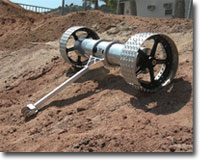
Moon Diver is a proposed lunar mission concept by NASA's Jet Propulsion Laboratory that would employ a robotic lander and a – distant coaxial – two-wheeled rover called Axel to investigate the exposed geological layers on the walls of a deep lunar pit.

Volcanism on the Moon is represented by the presence of volcanoes, pyroclastic deposits and vast lava plains on the lunar surface. The volcanoes are typically in the form of small domes and cones that form large volcanic complexes and isolated edifices. Calderas, large-scale collapse features generally formed late in a volcanic eruptive episode, are exceptionally rare on the Moon. Lunar pyroclastic deposits are the result of lava fountain eruptions from volatile-laden basaltic magmas rapidly ascending from deep mantle sources and erupting as a spray of magma, forming tiny glass beads. However, pyroclastic deposits formed by less common non-basaltic explosive eruptions are also thought to exist on the Moon. Lunar lava plains cover large swaths of the Moon's surface and consist mainly of voluminous basaltic flows. They contain a number of volcanic features related to the cooling of lava, including lava tubes, rilles and wrinkle ridges.






















